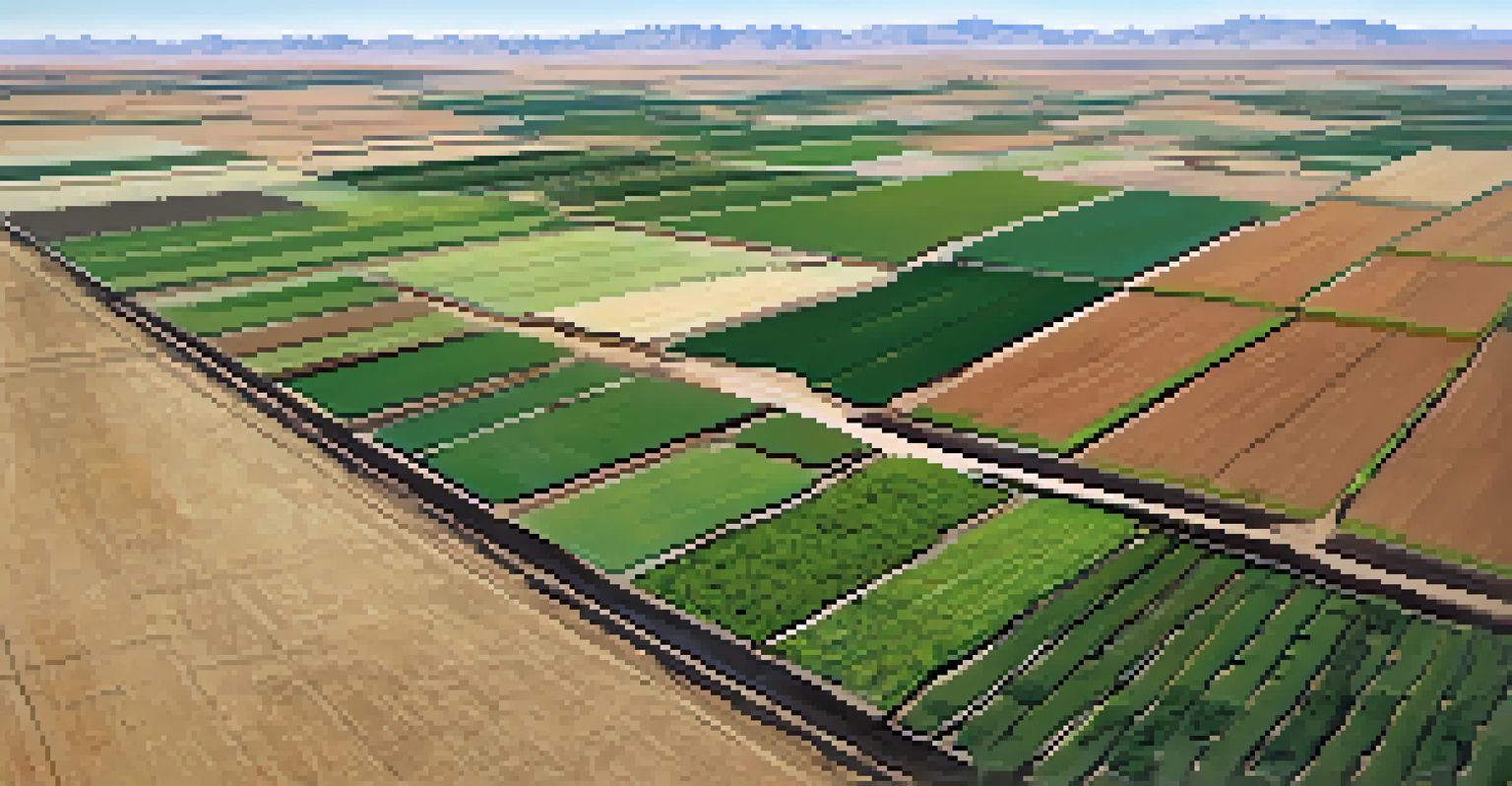Climate Change's Impact on Crop Production in Arizona

Understanding Climate Change and Its Global Impact
Climate change refers to long-term shifts in temperatures and weather patterns, primarily caused by human activities. It's not just a distant problem; it’s affecting us now, leading to unpredictable weather and extreme conditions. These shifts can disrupt agricultural practices worldwide, and Arizona is no exception.
We cannot solve our problems with the same thinking we used when we created them.
As temperatures rise and rainfall becomes less predictable, farmers face significant challenges. In Arizona, where agriculture is vital, these changes can lead to reduced crop yields and increased susceptibility to pests. The impact of climate change is a pressing concern, urging us to rethink farming practices.
By understanding these global changes, we can better appreciate their local effects. Arizona farmers are on the front lines of this battle, witnessing firsthand how shifting climates can alter their livelihoods. This knowledge is essential for developing strategies to adapt and thrive.
Arizona's Unique Climate and Agricultural Landscape
Arizona is known for its diverse climate, ranging from arid deserts to higher elevation regions with more moisture. This diversity allows for a variety of crops, including cotton, citrus, and vegetables, which are crucial for both local and national markets. However, the state's reliance on specific climate conditions makes it particularly vulnerable to climate change.

The existing water scarcity in Arizona adds another layer of complexity. With increasing temperatures, the demand for water rises, while drought conditions can limit supply. This makes it more challenging for farmers to maintain healthy crops and ensure a steady food supply.
Climate Change Threatens Agriculture
Arizona farmers are facing significant challenges due to climate change, including unpredictable weather, reduced crop yields, and increased pest pressures.
Understanding Arizona's agricultural landscape highlights the importance of sustainable practices. Farmers are now exploring methods like drip irrigation and crop rotation to maximize water efficiency and enhance resilience against climate fluctuations. It’s a delicate balance that requires constant adaptation.
Temperature Increases and Crop Stress
One of the most noticeable effects of climate change is the rise in average temperatures. In Arizona, this increase can lead to significant crop stress, especially for temperature-sensitive plants. High heat can cause crops to wilt and reduce overall yields, impacting both quality and quantity.
The earth does not belong to us: we belong to the earth.
Moreover, extreme heat events can lead to a phenomenon known as heat stress, where plants struggle to survive. For instance, crops like wheat and corn may not pollinate effectively under high temperatures, ultimately leading to lower harvests. This scenario puts pressure on farmers to find ways to mitigate these risks.
Farmers are experimenting with heat-resistant crop varieties and adjusting planting times to combat this challenge. While these approaches can help, they also require investment and research, emphasizing the need for support from agricultural organizations and government policies.
Changing Rainfall Patterns and Water Supply
Climate change has also altered rainfall patterns across Arizona, leading to unpredictable water supply. Some regions may experience intense storms followed by prolonged dry spells, creating challenges for irrigation. For farmers, this inconsistency can spell disaster for crop planning and management.
When heavy rains occur, they can cause flooding, washing away topsoil and damaging crops. Conversely, drought conditions can lead to water shortages, making it difficult to irrigate fields. These fluctuations necessitate adaptive strategies to ensure crops receive the right amount of water at the right time.
Water Scarcity Complicates Farming
The existing water scarcity in Arizona, exacerbated by climate change, makes irrigation and crop maintenance increasingly difficult for farmers.
Innovative solutions, such as rainwater harvesting and improved irrigation systems, can help farmers manage water resources more effectively. By embracing these strategies, they can better prepare for the uncertainties brought by climate change and safeguard their livelihoods.
Pest and Disease Proliferation Due to Climate Change
As temperatures rise and weather patterns shift, the prevalence of pests and diseases in crops is also changing. Warmer conditions can create a more favorable environment for pests, which can thrive and multiply more rapidly. This poses a serious threat to crop production in Arizona, where farmers are already dealing with established pest problems.
In addition to increasing pest populations, climate change can alter the lifecycle and behavior of these pests. For example, some insects may emerge earlier in the season, leading to potential overlaps with crop planting times. This can result in greater crop damage and increased reliance on pesticides, which have their own environmental impacts.
To combat these challenges, farmers are focusing on integrated pest management strategies that combine biological controls, crop rotation, and targeted pesticide use. This collaborative approach not only helps protect crops but also promotes a healthier ecosystem overall.
Economic Implications for Arizona Farmers
The effects of climate change on crop production come with significant economic implications for farmers in Arizona. Reduced yields and increased production costs can severely impact profitability and sustainability. Farmers may find themselves in a precarious position as they navigate these unprecedented challenges.
As crops fail or yield less, farmers may face decreased income, which can ripple through the local economy. Additionally, the rising costs of adapting to climate change—whether through new technologies or improved irrigation systems—can be burdensome for many. This economic strain can lead to tough decisions about which crops to grow or whether to continue farming altogether.
Sustainable Practices for Resilience
Farmers in Arizona are adopting sustainable agricultural practices, such as precision farming and crop diversification, to enhance resilience against climate impacts.
Support from the government and agricultural organizations can play a vital role in helping farmers adapt to these changes. By providing resources and funding for sustainable practices, we can help ensure that Arizona's agricultural sector remains resilient in the face of climate change.
Adapting Agricultural Practices for Resilience
To mitigate the impacts of climate change, Arizona farmers are increasingly adopting sustainable agricultural practices. These methods prioritize soil health, water management, and crop diversification, which can enhance resilience against changing conditions. For instance, cover cropping helps improve soil structure and moisture retention.
Farmers are also experimenting with precision agriculture, utilizing technology to optimize planting and irrigation. This data-driven approach allows for more efficient resource use, minimizing waste and maximizing yield potential. By adapting their practices, farmers can better withstand the challenges posed by climate change.

Education and collaboration among farmers, researchers, and policymakers will be critical in this transition. Sharing knowledge and resources can foster a community of innovation, helping to build a more sustainable agricultural future in Arizona. Together, we can work towards a resilient farming landscape that thrives despite climate uncertainties.